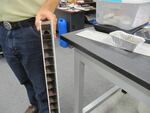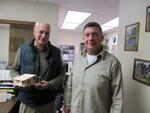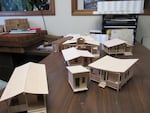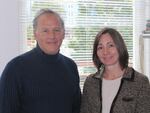
PSU engineering graduate student Seth Moody holding sample of Pacific Green Innovations’ building material.
Rob Manning
PORTLAND -- A local manufacturer's plans to build thousands of houses in Haiti using "green" construction boards is being questioned by a local engineering lab as to whether it can hold up in the Haitian climate.
The product goes by several names, including SwissCell and Honeycomb. It uses lightweight building sheets with a honeycomb of treated paper inside. The idea is to provide a strong but cheap construction board, sometimes made with entirely recycled materials.
The Portland-based company that hopes to manufacture the product in Haiti is Pacific Green Innovations, run by CEO Charles Fox. But a Portland lab tested samples of the product supplied by Pacific Green, in conditions simulating the intensely hot and humid environment of Haiti. That test raised serious questions about whether the material is ready to use in the construction of homes.
The story starts more than two years ago, with Charles Fox.
Charles Fox: "Originally we had been visiting with some people that had created what they called 'SwissCell.'"
Charles Fox initially wanted to use "SwissCell," a European invention, for doors and countertops. Then in January 2010, an enormous earthquake shook Haiti.
Charles Fox: "I realized there was something far more important we could be doing, rather than putting up doors and countertops with this. That we had a product that could be used to build homes in Haiti that we could put up quick shelters with."
Pacific Green Innovations started developing its own magnesium board-based product with honeycombed paper inside.
At first, Fox's goal was to build 1,000 homes in Haiti. More recently, he talked about a longer-term goal of 10,000 homes. The company joined with Portland State University to put a demonstration home on the South Park Blocks, a year ago June.
The house was taken down, and then re-assembled a few miles west in Beaverton. Watching along the way was PSU engineering professor, Sergio Palleroni. He says he saw something troubling, when his students were taking down the Haiti house they'd put up with Pacific Green.
Sergio Palleroni: "Both when we started to take it apart here and later in Beaverton, when it began to hit the rainy season that we began to realize there was a little of a salt or a powder surface on it, and we were wondering why this was happening, if it was totally water-impregnable."
So, Palleroni brought some pieces of the building material back to the PSU Green Building Lab to get a class of graduate students to check it out. Seth Moody was one of them.
Seth Moody: "The outside portions of the material absorbed a huge amount of water and really lost its structural capability, and therefore then really could not maintain its form with the honeycomb. So under loads – under bending loads, it basically just delaminated, very quickly."
Sergio Palleroni says the lab tested the product repeatedly and found moisture and similar delaminating— or peeling problems. The test results submitted to Pacific Green Innovations recommended against using the magnesium and honeycomb material in environments like Haiti.
Sergio Palleroni: "It's only when you measure it, that you find that it's actually losing – and we ran this test various times – about 60-or-more percent of its structural integrity."
Pacific Green Innovations contends Palleroni didn't test the product correctly – though the company did supply material to the university. Pacific Green's operations' director John Moore says PSU should have tested boards with coating that wasn’t on the sample PSU tested. He says that coating would be used on the materials for houses that will be built.
John Moore: "So, if you would've put the other coatings on and whatnot, I think it would've been a different test result."
Moore says the boards they're using now are different from what PSU tested. And Charles Fox says he's gotten the reassurance he needs from the supplier that the product is safe to use in Haiti.
Charles Fox: "The supplier of the material has 20-thousand hours of testing on the material, and they stand fully behind the fact that it can be used in Haiti, and throughout the Caribbean, and in tropical climates. They've gone so far as to put a 30-year warranty on it."
But PSU’s Palleroni defends his methods, saying the siding is very difficult to coat adequately. He says he's hoping the company will find a way to make the product work.
Sergio Palleroni: "They're continuing to develop it –- it's a product in development. If they can hit it on the nose, it has tremendous potential because it's basically made of the two materials that make up most of our waste dumps."
But Palleroni is concerned that while the product is being developed, Fox is headed toward production.
Makers of the original SwissCell product Fox looked at has already gone out of business trying to "hit it on the nose" as Palleroni would say. In an email, SwissCell's trade agent agreed that the honeycomb material is prone to moisture problems -– but he couldn't speak specifically to the combination with magnesium board that Pacific Green is using.
Pacific Green acknowledges that the product is continuing to evolve. CEO Charles Fox says after nearly losing one-third of his private equity, a factory in Haiti will soon roll out housing panels for everything from homes to orphanages. But Fox says he's not setting goals in terms of thousands of homes anymore.
Charles Fox: "We want to build as many homes as possible. But it's going to take a lot of different efforts from a lot of different groups in order to get that. Can we build 10-thousand homes ourselves? Absolutely not. Can they get 10-thousand homes out of that one factory? Probably not. Can we open another factory? Absolutely."
Fox says he has everything in place to open a factory with 300 Haitians on the payroll, with enough material to build about 40 homes. He says housing panels could roll out the door as soon as or three weeks. Sergio Palleroni at Portland State University has plans to be in Haiti, too. He won a grant a few months ago to study sustainable building in the developing world, on the island.
(This was first reported for opbnews.org)



